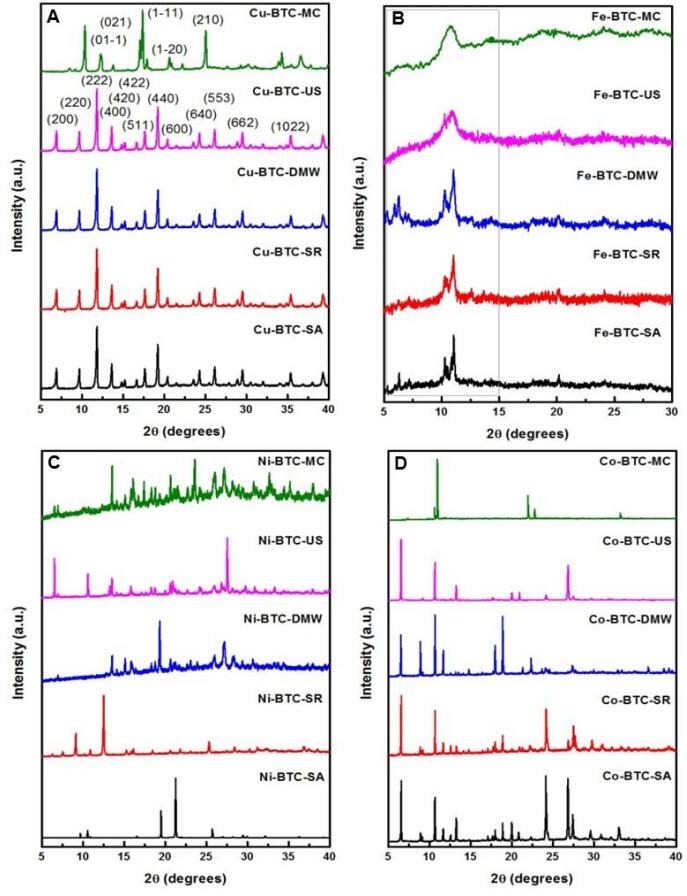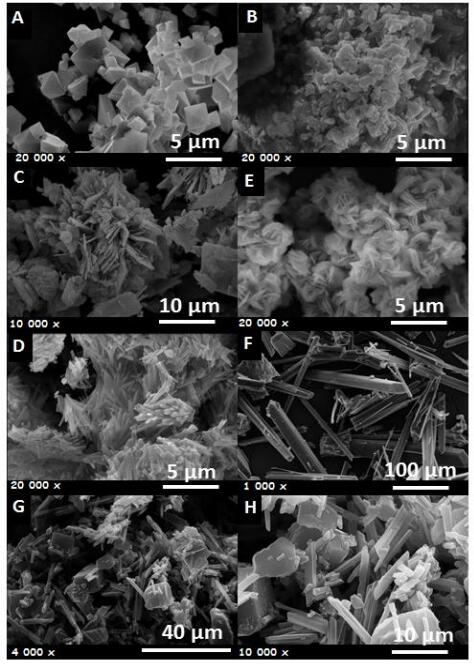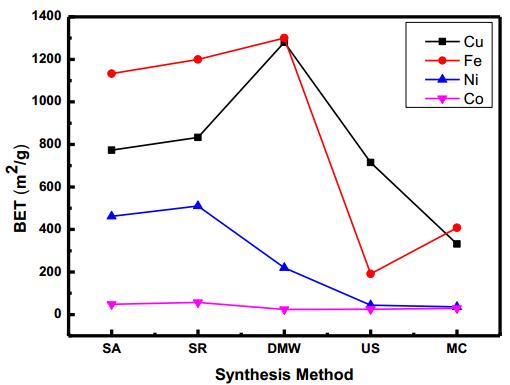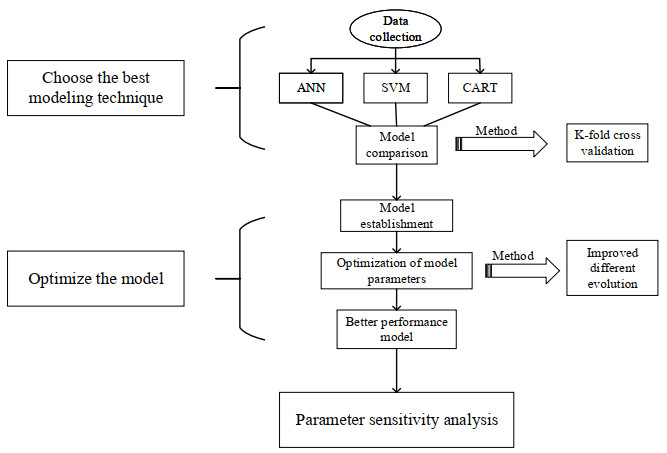1. Introduction
Since the design of the first polymer framework by Hoskin and Robson in 1990 [1], numerous studies have been published documenting the production of a wide variety of metal organic frameworks (MOFs), though despite the large number of publications, these materials only received their official designation by IUPAC in 2013 [2]. From this time to the present, MOFs have attracted tremendous research interest in different areas [3]. Metal organic frameworks (MOFs) are an attractive class of porous materials that consist of a metal center or cluster coordinated through a polydentate organic linker. The applications of these structures include gas storage [4], purification and separation of molecules [5,6], catalysis [7,8], electrochemical sensing [9,10,11], environmental chemistry [12], and as templates for nanostructures [13].
Transition-metal-based MOFs are the most commonly synthesized and applied MOFs, mainly because transition metals have variable valence and have shown good catalytic properties [14]. The M3(BTC)2·xH2O class of metal organic frameworks (where M = Fe, Ni, Co, Cu; BTC = benzene-1, 3, 5-tricarboxylate) have been much studied because they are easily synthesized MOFs which can be applied in many areas, leading to their production for industrial and medical applications. Materials of this class exhibit a moderate amount of surface area, as well as active sites for catalytic applications. In particular, researchers from the Institut Lavoisier in Versailles have spent much effort on the preparation of transition-metal-MOFs, leading this class of MOFs to be designated MIL (Materials of Institute Lavoisier). Besides the high surface area, these materials exhibit high porosity and hydrothermal stability, which allows their application in several areas, mainly in catalysis due to the presence of mesopores [15,16].
These materials, however, are commonly prepared by solvothermal synthesis [17]. This method has some drawbacks, such as synthesis high temperatures and long reaction times [18]. Furthermore, some mineralization agents are used and while this is undesirable for the environment, it is indispensable for some synthesis routes, e.g., Fe-BTC and Co-BTC, but other works have shown that it is possible to produce M-BTCs under green conditions [19,20,21,22]. Thus, we are encouraged to prepare these MOFs using water and ethanol as solvents and at temperatures less than 100 ℃, to evaluate the best facile synthesis method for these MOFs. The domestic microwave oven may be the key to a faster, easier, and lower cost method for synthesizing transition-metal-MOFs with good chemical properties.
Thus, different structures based on M = Fe, Ni, Co, Cu have been synthesized. In the literature, descriptions of a series of compounds of the form M3(BTC)2 (M = Cr, Fe, Ni, Co, Cu, Mo, Ru, Ln) can be found [23,24,25]. So far, the reported synthesis methods have mainly been solvothermal methods [17,19,26], resulting in MOFs similar to the Cu-BTC, Fe-BTC, and Ni-BTC compounds commercially marketed by Sigma-Aldrich, but with low crystallinity [23,24]. To the best of our knowledge, there have been few reports evaluating the different synthesis methods for these materials until now [27,28]. The reaction conditions for the synthesis of transition-metal-BTCs using a domestic microwave have been reported recently [29], however, the laboratory used a stoichiometric amount of NaOH added to the reaction mixture and did not control the temperature, which can be different depending on the particular microwave oven used. Our group has shown that it is possible to control the size and morphology of a Zn-BTC MOF in a domestic microwave oven [30]. In this study, we report a synthesis route for M3(BTC)2 MOFs with good chemical properties. In our study, along with conventional heating, microwave, sonochemical, and mechanochemical methods have been introduced to better evaluate the synthetic methods.
The aim of the present work is to develop a general discussion of the different synthetic methods for transition-metal-MOFs (M = Cu, Fe, Ni, Co and O = BTC) with a special focus on using a domestic microwave oven. Some previous authors have demonstrated these methods and the production of MOFs with control over the structure formation [31,32]. However, our results are complementary to these studies and may provide greater insight into the parameters which favor the fast and easy formation of MOFs.
2. Materials and methods
2.1. Materials
All of the following chemicals were used as received: benzene-1, 3, 5-tricarboxylate (BTC) (Sigma Aldrich, 99%), Fe(Ⅲ) (Fe(NO3)2·9H2O), Co(Ⅱ) (CoCl2·6H2O), Ni(Ⅲ) (Ni(NO3)2·6H2O), Cu(Ⅱ) (Cu(NO3)2·6H2O), ethanol (Anidrol), acetone (Anidrol), methanol (Anidrol), DMF (Synth) and Milli-Q water.
2.2. Synthesis of MOFs
2.2.1. General procedure
The conditions of the synthesis methods are described in the following sections. All synthetic procedures with the exception of the mechanochemical were carried out as follows: the two precursors (metal and linker) were dissolved separately and then mixed for 10 min. After the reaction, the mixture was cooled down and the solid material was centrifuged and, when necessary, purified with solvent changes. The solid was left to dry for 8 h before characterization and activated at 150 ℃ for 3 h under vacuum for physisorption analysis. The following equipment was used for the syntheses: Teflon-lined autoclave, reflux systems, domestic microwave oven (Consul®), ultrasonic probe (Fisherbrand™ Q500 Sonicator), planetary ball mill "PM100" (Retsch®). Detailed descriptions of the synthesis methods are provided in Scheme S1 in the Supporting Information.
2.2.2. Solvothermal synthesis in a pressure vessel (SA)
For this synthesis, the metal salt (Fe, Co, Ni and Cu) (see quantitative values in Scheme S1) was dissolved in an appropriate solvent, i.e., deionized water, ethanol and/or DMF. The BTC was dissolved in ethanol, and the resulting mixture was transferred into a Teflon-lined autoclave and heated to 80–100 ℃ for 12–48 h.
2.2.3. Solvothermal synthesis under ambient pressure at reflux (SR)
The metal salt (Fe, Co, Ni and Cu) (see quantitative values in Scheme S1) was dissolved in an appropriate solvent, i.e., deionized water or ethanol, and the linker BTC in ethanol. They were then mixed together and heated under reflux for 12 to 48 h.
2.2.4. Domestic microwave assisted synthesis (DMW)
The metal salt (Fe, Co, Ni and Cu) (see quantitative values in Scheme S1) was dissolved in an appropriate solvent, i.e., deionized water or ethanol, and the linker BTC in ethanol. The solutions were mixed and then transferred into a 50 mL vessel. The reaction was carried out in a Consul® domestic microwave oven (Model CMS26ABANA) with 2450 MHz at maximum power of 80% of 800 W for a period of 5 min. After reaction, the solution was cooled down and centrifuged to recover the solid.
2.2.5. Ultrasonic irradiation synthesis (US)
The metal salt (Fe, Co, Ni and Cu) (see quantitative values in Scheme S1) was dissolved in an appropriate solvent, i.e., deionized water or ethanol, and the linker BTC in ethanol. The solutions were mixed and then exposed to ultrasonic irradiation for 30 min (pulse-mode: 50%, power: 95%).
2.2.6. Mechanochemical synthesis (MC)
The metal salt (Fe, Co, Ni and Cu) (see quantitative values in Scheme S1) was separated, dried, and mixed with the linker BTC. Then solvent free mechanochemical synthesis was carried out in a high energy ball mill by grinding of the reactants. The reactants were placed in a 25 mL stainless steel grinding jar and then mixed at 30 Hz for 60 min. After this time, the reacted material was collected and washed with ethanol/methanol several times to remove any unreacted species.
2.3. Characterization
X-ray diffraction patterns of all samples were obtained using a Shimadzu 6000 X-ray diffractometer (XRD), with a Cu radiation source operating at 40 kV and 40 mA; the diffraction intensity was recorded over the 2θ range of 5–40° with a step of 0.001°. The crystal size and morphology were examined using a scanning electron microscope (SEM, NovaNano-SEM, Co. FEI). The physisorption analyses were performed by measuring N2 adsorption–desorption isotherms at liquid nitrogen temperature (77 K) after activation under vacuum at 150 ℃ for 3 h using a Quantachrome NOVA 1200e. The specific surface areas were evaluated using the Brunauer–Emmett–Teller (BET) method in the p/p0 range of 0.05–0.23.
3. Results and discussion
3.1. Synthesis of MOFs
The reaction of a metal with BTC yields blue (Cu), orange (Fe), green (Ni) and red (Co) crystals. The relative yields of Fe-BTC and Cu-BTC synthesis were in the 70–97% range. The Co and Ni-BTCs presented yields of 50–80%, depending on the applied method. Figure 1 shows the XRD patterns of the as synthesized M-BTC (M = Cu, Fe, Ni, Co) obtained from the five synthesis methods, suggesting the optimum method for each metal. In agreement with previous works reporting the synthesis of Cu-BTC (Figure 1A), all the diffraction peaks exactly matched the peaks of the simulated structure based on CIF 2300380; the patterns of SA, SR, DMW, and US produced samples are indexed in accordance with the literature and no additional peaks from impurities were detected, which clearly suggests that pure and isostructural Cu-BTC MOFs were formed. The Cu-BTC formed via MC (Figure 1A green) presents some peaks consistent with this structure but also shows evidence of an impurity in the form of trimesic acid, which was correlated to CIF 7051122. Figure 1B shows the XRD patterns for the Fe-BTCs made by SA, SR and DMW; the main peaks at the 2θ regions of 5–7° and 10–15° were indexed to CIF 7102029. For the US and MC synthesized Fe-BTCs, the XRD pattern has the amorphous shape of MIL-100, which is characteristic of this MOF when no acid is used in the synthesis. It is clear that the DMW synthesis resulted in better crystallinity.
The XRD patterns for the Ni-BTCs are shown in Figure 1C. In agreement with previous works, the XRD patterns show different diffraction peaks because different crystal structures were formed. The XRD patterns from the Ni-BTCs are different from those reported in various studies because the researchers in those studies used a variety of solvents, precursors, base solution reaction temperatures, synthesis routes, and reactant concentrations. As shown here, these factors have a strong influence on the final product [33]. It is noteworthy that all structures showed good crystallinity; however, this is more pronounced in the materials obtained by conventional methods. It is important to highlight that the Ni-BTCs were obtained in various combinations of phases, showing unique XRD patterns. The Co-BTCs showed similar results, as shown in Figure 1D. This means that while we observe some different patterns than those reported in the literature, on the other hand, we observe others which are similar to the reported ones [34]. For the Co-BTC synthesized via MC, we obtained a different crystal structure that can be explained by impurities from the BTC.
The scanning electron microscopy (SEM) images in Figure 2 show that the fully crystallized M-BTCs obtained by conventional heating and the domestic microwave are composed of relatively small particles. The SEM image of the Cu-BTC (Figure 2A) shows a typical octahedral morphology. The Fe-BTC (Figure 2B) did not show a morphological type that is typical for this MOF. The SEM images presented in Figure S1A–D show the same morphological type for Fe-BTCs made by US and MC, but the Cu-BTC shows an octahedral type morphology only when made by US. The SEM image of the Ni-BTC obtained by a conventional method (Figure 2C) shows a thin plate morphology, while the image of the Ni-BTC obtained by a reflux method (Figure 2E) presents a well-defined cylindrical morphology. The Ni-BTC obtained by microwave heating showed flower type morphology (Figure 2D). The Ni-BTCs from US and MC showed different morphologies as well (Figure S1E, G). This is consistent with the XRD patterns, which indicated the formation of different structures. The Co-BTC SEM images showed the same morphological type (Figure 2F–H), however different structures were observed from Co-BTCs synthesized by US and MC methods (Figure S1F, H).
The nitrogen-adsorption isotherms of fully crystallized M-BTCs synthesized by conventional and domestic microwave methods shown in Figure 3 are typical of type Ⅳ isotherms which illustrate the meso/microporosity of the M-BTCs and confirm the successful synthesis of porous Cu-BTCs and Fe-BTCs. The BET surface areas for Cu-BTCs (Figure 3A) were determined to be 773 m2/g (SA: black curve), 833 m2/g (SR: red curve), 1280 m2/g (DMW: blue curve), 715 m2/g (US: pink curve), and 332 m2/g (MC: green curve). The BET surface area obtained from conventional heating was lower than the previously reported values of around 1253 m2/g for EtOH/H2O. This can be attributed to the activation process. But, Cu-BTC obtained via DMW showed a similar surface area to the literature values (1253–1143 m2/g). The mechanochemical method showed a low specific surface area when compared to previous works [27], which might be attributed to the use of a different ball-mill apparatus.
Fe-BTC obtained by the domestic microwave method (DMW: red) showed a BET specific surface area of 1300 m2/g, which is higher than those of the samples obtained by conventional heating, 1133 m2/g (SA: black) and 1220 m2/g (SR: blue) (Figure 3B). However, the surface areas measured for the US (pink) and MC (green) samples were lower, at 191 and 408 m2/g, respectively. The improved specific surface area for the microwave sample is probably due to reduced particle sizes (see Figure 2B). The nitrogen-adsorption isotherms of the Ni-BTCs synthesized by all five methods (Figure 3C) also show permanent porosity and the calculated BET surface areas are comparable to the literature values. The largest BET specific surface areas were obtained from conventional heating, at 462 m2/g (SA: black) and 510 m2/g (SR: blue). The Ni-BTC obtained from DMW (red) showed a low BET specific surface area of 220 m2/g, but this is still higher than those shown by the US (pink) and MC (green) synthesized BTCs at 44 m2/g and 59 m2/g.
It is worth noting that these results are quite close to other results recently obtained for this structure [35]. Co-BTC was found to show an extremely low BET specific surface area of 57 to 24 m2/g. However, when compared to other characterizations, this structure is the same as previously reported and shows excellent adsorption [36], though the surface area was not mentioned in that report.
To understand the best synthesis method for each of the M-BTCs, BET specific surface areas were compared. As shown in Figure 4, the results were very good for Cu- and Fe-BTC obtained from domestic microwave irradiation. There are no noticeable differences between the conventional heating methods. However, the sonochemical and mechanochemical methods are worse for all metal centers; this might be the case because the US and MC apparatus need to be adjusted for better results. The MOF structures formed by Ni and Co commonly present lower surface areas when compared to MOFs with Fe or Cu metal centers.
4. Conclusions
Metal organic frameworks of the form M-BTCs (M = Fe, Ni, Co, Cu) can be easily synthesized in a domestic microwave oven within minutes at 90 ℃ under non-solvothermal conditions. The synthesized M-BTCs show relatively small and homogeneous particles, and maintained surface areas comparable to those obtained via conventional synthesis methods and in previous works at solvothermal conditions. The observed results suggest that the domestic microwave can be used to prepare these structures by a low cost and facile synthesis method, suitable for teaching labs and laboratories with low resources. These materials with meso- and micropores should be further investigated for application as catalysts.
Acknowledgments
This work is financially supported by the CNPQ process: 202093/2014-0 and 428017/2016-9, CAPES and Fundação Araucária process: 820/2013. Thanks to the facilities from COMCAP-UEM.
Conflict of interest
The authors declare that they have no conflict of interests in this work.










 DownLoad:
DownLoad: 













